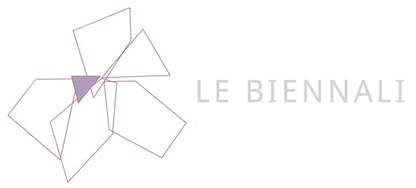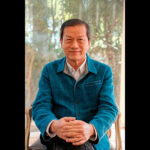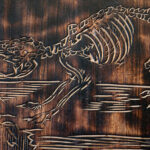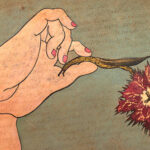Roma – 19 Marzo 2017 by Suzanna Queiroga
Preparation
When I was invited to the IV International Biennial of Contemporary Art of the End Of The World, which theme was “Contrasts And Utopias”, I could not help but consider the original geographic condition of this Biennial, located in distant and border territories, between the end of the Southern Cone and the beginning of Antarctica.
Faced with the idea of the boundary of horizon and the boundaries of landscape, I considered generating, through my artwork, an atmosphere of reflection on the present moment, thinking of broader and more collapsed geographies like those emerging from the great environmental transformations promoted by mankind, discussing the presence of water and air in the maintenance of our lives and proposing, in the end, an essential reflection about time, flow and death. The crucial questions concerning this artwork would be: “What does remain of our certainties before a boundary horizon (between the waters and the skies)? What does remain of ourselves in face of the inevitable transformation of our own idea of world and humanity?
I used the notion of Ocean, such as thought by the Greeks in antiquity, Ωκεανός, which comprised the gigantic body of water enveloping the Earth as a great river continuously flowing, so as to eternally return to its beginning. In my project for the Limits installation, the systems of waters, rivers and their affluents, oceans and seas, would be seen seen from above, like in a flight, in which the location is fluid and from whence reality seems poetry to us.
I would bring several elements to this space: drawings and paintings directly on the wall, polaroids, mappings, objects collection, texts, two small inflatable hot air balloon replicas among other materials to be collected by my investigations in loco during a period of artistic residency which would precede the inauguration of the exhibition. The whole assembled set would be arranged in a room so that the viewers could make up their own narratives, taking part in a fluid experience of observation, displacement and action, creating for themselves the conditions to write and add elements, so that, at the end of the exhibition, we would have the totality of my narratives added by those of the various visitors.Reality
During the preparation of my proposal, in response to the invitation from the curatorship, I learned that this edition of the Biennial would no longer take place in its original location, Ushuaia, but rather in Mar del Plata; therefore, my artistic residency and the preparation of my artwork would no longer be facing a boundary between the Antarctic ice and the end of our civilization in the Southern Cone, but in a sunny seaside town with its endless stones houses preparing for one more summer and the usual invasion of tourists.
I have kept my initial proposal, imagining how this work would take place in a completely different geography from the one I have dreamed of. After all, I would still have those expected 15 days of residency to explore those possibilities of the place and articulate the whole work in space. I planned to immediately start with the graphic interference and the direct paint on the wall because they were more time-consuming, and, in my daily trips around the city, I would photograph and collect those elements for my installation. The radical change of environment became a very interesting challenge, although it meant completely changing the initial conception of my artwork.Another Reality
Arriving in Mar del Plata, it soon became clear that the place to which I was assigned was an old girls’ orphanage, Azilo Unzué, which had been restored and transformed into the Unzué Cultural Space. On reaching the second-floor, in a huge hall, I realized that this was the largest room with the greatest number of windows I had ever seen. A gigantic space, which probably would have been one of the two dormitory halls of the hundreds of orphan girls who lived there. A surprising atmosphere and space, countless windows, hardly any walls and nothing resembling that intimate atmosphere I had imagined for my own project… Everything there was solar, landscape and memory. It was impossible not to imagine those girls running through the gardens, entering the building, having nightmares at night in that huge hall by the sea. We could still hear the sound of waves of the beach next door, even though today Mar del Plata is a big city full of cars. How would all of this have been in those days when the asylum was built? What would it have been like to live in a place completely cut off from the rest of the world? And how could so many orphaned girls exist in that small town? Where would they have come from? Why would they have been abandoned? How much isolation, sadness and pain were there?… However, at the same time, there was something surprisingly light and cheerful brought by a generous architecture, by the constant presence of light and wind. Footsteps could be heard in the distance, inner silences as deep as the enormous extent to which our hearing reached.Transformation
Walls there were none, isolation also none, and what to do in this new context? Panels simulating walls to be constructed would be assembled only the day before the inauguration. The photographs I began to take did not fit in with my initial ideas, and I felt completely lost. I had to accept the fact that everything had to be reinvented and that my initial project had become an impossibility. So I concentrated on making small drawings with some blue papers (those hand-tinted papers I had prepared in my atelier before the trip), they were not too many, but enough to try something. I thought of water, river flows, tides, thermodynamics of fluids, and tried to delicately connect the ideas through gouache on paper. The elements, little by little, appeared in the drawing. It took fifteen days of work in the gigantic hall of Unzué Space, sharing abyssal silences alternating with genial conversations with Cadu, another Brazilian artist also taking part in the Biennial and in the artistic residency. Gradually, we’ve met other artists and curators and started to observe that adverse situations and technical difficulties were experienced by everyone in other spaces where the Biennial was also being prepared.
Those were intense days, at both possible levels of intensity, that of my own immersion in work and that of insecurity with problems, which led me to unforeseen enterprises in relation to my initial expectations, bypassing and surprising the directions of initial project. Perhaps the daily emotional seesaw facing such a sunny and sweeping landscape has brought about some transformation. It has, of course, somehow brought it about.
After a few assembly tests, I finally decided on a fairly simple solution. I had brought from Brazil two miniature hot air balloon replicas. I’ve set them up suspended in the room. The small blue aircrafts became two tension poles, as if one pulled the other one, each of them to an opposite side. That is exactly how we technically solved this art installation, with delicate threads balancing the forces of suspension of those objects in the air. Beneath those balloons, on the ground, a small map of the Southern Cone, a very delicate and hand-cut one. The day before the inauguration, a small panel was finally set up, on which I was finally able to assemble my little drawings.
In Mar del Plata, everything happened in a completely different way from what I had firstly imagined and I had to deal with new endless yearnings and doubts every day. The initial project (still not carried out to date!) was that of a giddy, gloomy space, full of elements, data, cartography, texts, in which the whole sinked under to catastrophe. Those circumstances redirected this project little by little, making it a more solar, although also desolating one in a double flight that does not resolve before the imminence of a crash. Tragic still, but death with sun shining down on and wind blowing in the face…PS:
For some other artists of the Biennial, the initial technical difficulties were finally overcome and the initial project was carried out close to or exactly like what had been planned. It was really impressive to see the ability of artists and curators who, in a very short period of time, have dealt with so many adverse circumstances and managed to perfectly assemble all those artworks!
PS1:
Special thanks to the chief-curator Massimo Scaringella for the invitation, to the curator of the Brazilian delegation, Rafael Raddi and to the Italian curators Fortunata Calabrò and Vittoria de Biasi. Also thanks to the artists Cadu, Valentina Collela, Fabio Pennacchia, Omar Castaneda and Jairo Valdati, to all, my gratitude for their fundamental partnership and support.
Contatti
www.suzanaqueiroga.com
https://www.facebook.com/suzana.queiroga
suzanaqueiroga@gmail.com
Suzana Queiroga was born in Rio de Janeiro, Brazil where she lives and works. Strongly active since the 1980’s Suzana Queiroga has been working with a large variety of mediums, including videos, performances, installations, inflatables, paintings, drawings and sculpture. Her work is related to the idea of flow and her pieces proposes an experience of expansion of the senses of space and of time. Her works have been shown internationally and she won several prizes in Brazil and Portugal.



